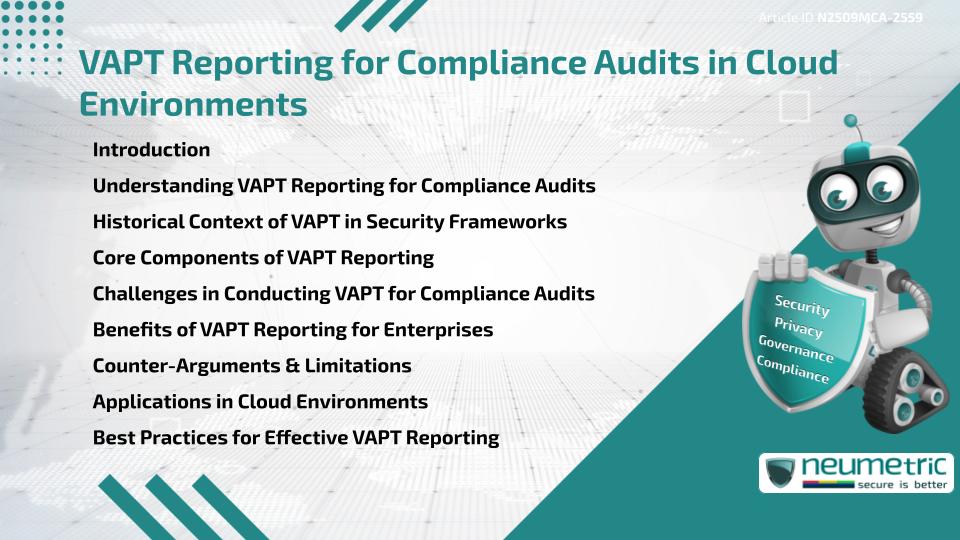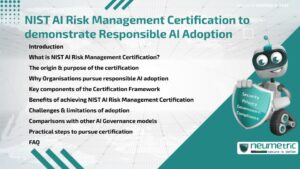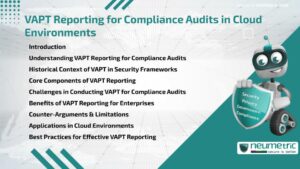Table of Contents
ToggleIntroduction
VAPT Reporting for Compliance Audits is an essential part of securing Cloud environments. Vulnerability Assessment & Penetration Testing [VAPT] helps Organisations identify weaknesses in Cloud systems, simulate real-world attacks & provide structured reports that demonstrate Compliance with Security Regulations. For enterprises, such reports are critical during Compliance Audits, as they show Regulators & Stakeholders that Risks are actively managed. Without VAPT Reporting, Organisations Risk failing Audits, facing Penalties & exposing Sensitive Data. This article explores what VAPT Reporting for Compliance Audits entails, its history, components, challenges, benefits, limitations & Best Practices in Cloud environments.
Understanding VAPT Reporting for Compliance Audits
VAPT combines two processes: Vulnerability Assessments, which detect potential weaknesses & Penetration Testing, which attempts to exploit those weaknesses to test resilience. The resulting report is a structured document that highlights identified Vulnerabilities, Risk levels, Remediation steps & Compliance mapping. Just as a medical report outlines a patient’s condition & treatment, a VAPT report provides Auditors with a clear picture of a system’s security & health. For Compliance Audits, this report serves as Evidence that an organisation has evaluated & mitigated its Cloud Security Risks.
Historical Context of VAPT in Security Frameworks
The use of Vulnerability testing began in the early days of Network Security, with tools developed in the 1990s to identify basic system flaws. As Cyber Threats evolved, Penetration Testing gained prominence by simulating real-world attacks. Frameworks like ISO 27001, NIST Cybersecurity Framework & PCI DSS began requiring or recommending VAPT activities as part of Compliance. With the rise of Cloud computing, VAPT became even more critical, as shared responsibility models increased the complexity of Security Management. Historical breaches caused by misconfigured Cloud services reinforced the importance of VAPT Reporting for Compliance Audits.
Core Components of VAPT Reporting
A comprehensive VAPT report typically includes:
- Executive Summary: High-level findings for Management & Auditors.
- Vulnerability Details: Identified flaws with severity ratings.
- Exploit Evidence: Documentation of successful Penetration attempts.
- Remediation Steps: Recommendations for fixing issues.
- Compliance Mapping: Alignment of findings with relevant regulations.
- Audit Trails: Documentation of methodology & tools used.
Together, these components form a complete picture of Cloud Security posture & provide Auditors with clear, actionable insights.
Challenges in Conducting VAPT for Compliance Audits
While valuable, VAPT Reporting for Compliance Audits is not without challenges. Cloud environments are dynamic, with resources frequently changing, making it difficult to maintain up-to-date testing. Organisations may also face conflicts between aggressive Penetration Testing & Service Availability. Cost is another concern, especially for smaller businesses with limited budgets. Furthermore, coordinating responsibilities between Cloud providers & Customers under shared responsibility models adds complexity.
Benefits of VAPT Reporting for Enterprises
The benefits of conducting & documenting VAPT are significant. Reports demonstrate Compliance, helping Organisations pass Audits with confidence. They reduce Risks by identifying Vulnerabilities before attackers exploit them. VAPT also strengthens Customer Trust, as Stakeholders see that Security is actively managed. Much like a Financial Audit builds investor confidence, a VAPT report builds confidence in an organisation’s Cloud Security posture.
Counter-Arguments & Limitations
Some argue that VAPT Reporting can be time-consuming & resource-intensive, diverting attention from other priorities. Others point out that a report is only a snapshot in time & cannot guarantee ongoing security. These concerns are valid, yet ignoring VAPT Risks greater consequences such as Breaches or failed Audits. The key is to integrate VAPT as a recurring, proactive measure rather than a one-time checkbox exercise.
Applications in Cloud Environments
In practice, VAPT Reporting for Compliance Audits is applied across industries. In Healthcare, it validates adherence to HIPAA by demonstrating secure handling of Patient Data. Financial institutions use it to comply with PCI DSS requirements for protecting payment information. Technology companies leverage VAPT Reporting to align with SOC 2 & ISO standards. Across sectors, Cloud environments rely on VAPT Reporting to bridge gaps between technical Security Controls & Regulatory obligations.
Best Practices for Effective VAPT Reporting
Organisations can improve VAPT Reporting by adopting Best Practices such as:
- Scheduling regular VAPT cycles to keep pace with Cloud changes.
- Using both automated tools & manual testing for thorough coverage.
- Ensuring Remediation steps are verified & documented.
- Mapping Vulnerabilities directly to Compliance frameworks.
- Maintaining collaboration between IT teams, Auditors & Cloud providers.
- Archiving reports for historical reference in future Audits.
By embedding these practices, enterprises ensure their VAPT reports are comprehensive, reliable & Audit-ready.
Conclusion
VAPT Reporting for Compliance Audits is vital for securing Cloud environments & meeting Regulatory obligations. It provides Auditors with Evidence of security testing, demonstrates proactive Risk Management & strengthens organisational Trust. Despite challenges & limitations, well-structured VAPT reports remain a cornerstone of Compliance in modern Cloud environments.
Takeaways
- VAPT Reporting for Compliance Audits validates Cloud Security posture for Regulators & Stakeholders.
- Reports include Vulnerabilities, Remediation steps, Compliance mapping & Audit trails.
- Challenges involve Cloud complexity, costs & shared responsibilities.
- Benefits include reduced Risk, stronger Trust & smoother Audits.
- Best Practices make VAPT Reporting effective, comprehensive & reliable.
FAQ
What is VAPT Reporting for Compliance Audits?
It is the structured documentation of Vulnerability Assessments & Penetration Testing results, used to demonstrate Security readiness during Compliance Audits.
Why is VAPT Reporting important in Cloud environments?
It helps identify Vulnerabilities, provides Auditors with Evidence of security efforts & ensures Compliance with regulations.
What does a typical VAPT report include?
It includes an executive summary, Vulnerability details, exploit Evidence, Remediation steps, Compliance mapping & Audit trails.
How often should VAPT Reporting be done?
It should be conducted regularly, especially after significant changes in Cloud infrastructure, to ensure reports remain accurate.
Does VAPT guarantee Compliance?
No, but it supports Compliance by providing Evidence of proactive testing & remediation, which is critical for Audits.
What challenges exist in conducting VAPT for Compliance Audits?
Challenges include dynamic Cloud environments, testing costs, resource availability & shared responsibility with providers.
Which industries rely on VAPT Reporting for Compliance Audits?
Industries like Healthcare, Finance, Government & Technology rely on VAPT to meet strict Security & Compliance standards.
Need help for Security, Privacy, Governance & VAPT?
Neumetric provides organisations the necessary help to achieve their Cybersecurity, Compliance, Governance, Privacy, Certifications & Pentesting needs.
Organisations & Businesses, specifically those which provide SaaS & AI Solutions in the Fintech, BFSI & other regulated sectors, usually need a Cybersecurity Partner for meeting & maintaining the ongoing Security & Privacy needs & requirements of their Enterprise Clients & Privacy conscious Customers.
SOC 2, ISO 27001, ISO 42001, NIST, HIPAA, HECVAT, EU GDPR are some of the Frameworks that are served by Fusion – a SaaS, multimodular, multitenant, centralised, automated, Cybersecurity & Compliance Management system.
Neumetric also provides Expert Services for technical security which covers VAPT for Web Applications, APIs, iOS & Android Mobile Apps, Security Testing for AWS & other Cloud Environments & Cloud Infrastructure & other similar scopes.
Reach out to us by Email or filling out the Contact Form…





